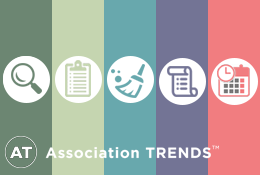
Association TRENDS 5-Step Data Cleansing Checklist
It is no secret. Data has become a key component of a successful and operational association. We live in the age of information, with millions of facts, figures, names, and numbers not only easily accessible but most of the time, right in our AMSs or prospect files. Success is no longer determined by who has the most data; it’s about who has the best, clean actionable data. If you’re like most associations, you’re in a constant cycle of cleaning dirty data from your AMS, LMS, and event registrations systems to name just a few. The Association TRENDS data team has extensive experience cleansing in-house data and has spent more than 40 years working in the association industry. Data cleansing can seem like a daunting task, so we’ve compiled a simple 5-Step Checklist to help get you started.
 1. Identify Data Requiring the Most Attention
1. Identify Data Requiring the Most Attention
In the association industry, we know better than most, a member profile isn’t just a name, number, and email address. It’s vital to know the relationship you have with that information. Why does it matter? What strategic decisions are based upon it? How are you using it currently? Identify what data is most critical to your goals and start there. It’s also helpful to identify what information is the messiest. Start small and take the process one step at a time.
 2. Create a Plan
2. Create a Plan
Creating a realistic, target cleansing plan will ensure less work for you and your organization downline. Can you identify bad records easily? Can you prioritize cleansing to ensure maximum efficiency? Decide what pieces of data are most critical to clean, and exclude less relevant pieces of data that can be ignored to save time. If you have missing data that is essential, it’s important to figure out the best way to fill those gaps. Whether that’s a targeted research effort, leveraging available internal or external resources, or working with third-party vendors, come up with a strategy and stick to it.
 3. Cleanse your Data
3. Cleanse your Data
Now the fun part! Identify duplicate records, merge where possible, or remove them, keeping most complete records in place. Flesh out incomplete records using fresh researched data, matched internal resources, or licensed third-party information. Always run your contact lists against known bad emails and mailing addresses to verify that your newly updated data is truly clean. Employ spreadsheet tricks to make your cleanup project maximally efficient.
 4. Institute Business Rules
4. Institute Business Rules
Now that you have your sparkling clean data, it’s time to put in practices to attempt to keep it that way. What inputs feed your database(s)? What business rules are in place to control data quality if any? Always keep in mind: bad data in; bad data out. Start to create or fortify rules that can be put in place to ensure data quality and data uniformity, giving special focus to mission-critical data. Finally (and this one is hard): Identify what data silos exist within your organization and make sure they are speaking to each other. Connecting unconnected systems is the best way to avoid data duplication or other easily avoidable errors.
 5. Schedule Regular Data Cleanup
5. Schedule Regular Data Cleanup
The world is constantly changing. Although a difficult truth to accept, your data becomes out-of-date the moment it’s updated. Regularly scheduled data cleanup efforts are necessary to keep databases current and relevant. To save time and money, focus more frequent cleanup efforts on your most critical information.
Clean data is effective data. Although the cleaning process can be laborious, it’s important to remember why this data exists, to begin with. We care about our industries, our organizations, and our members, thus, we care about the accuracy and precision of what makes them work. Access to clean data will be a key currency to determining who succeeds in an increasingly data-driven future.
Do you need more assistance with your data cleansing process? Association TRENDS’ data services offer data cleansing, modeling, and research to guarantee your data is at its best. Visit http://www.associationtrends.com/data-services-associations for more information. We can’t wait to hear from you!


